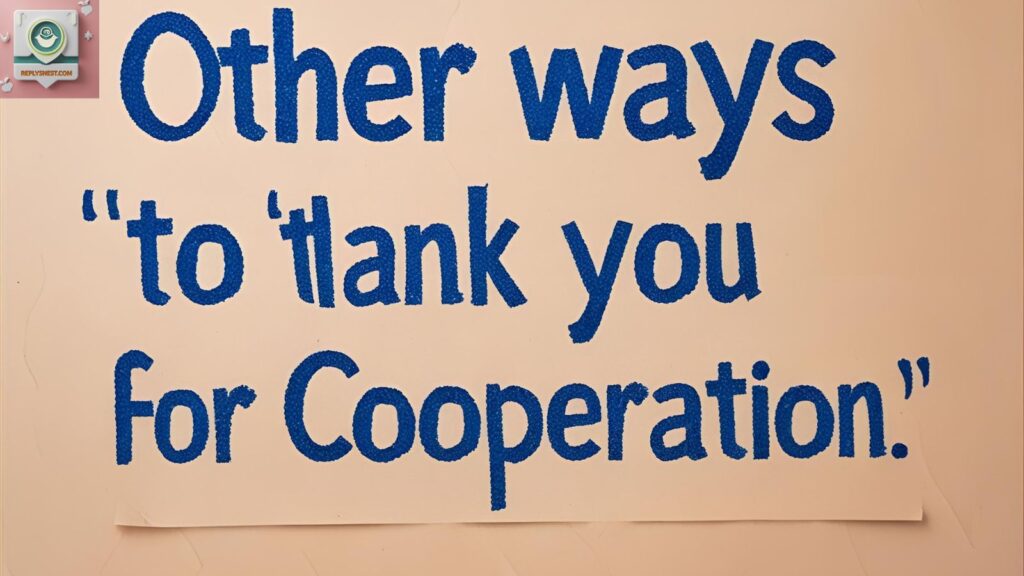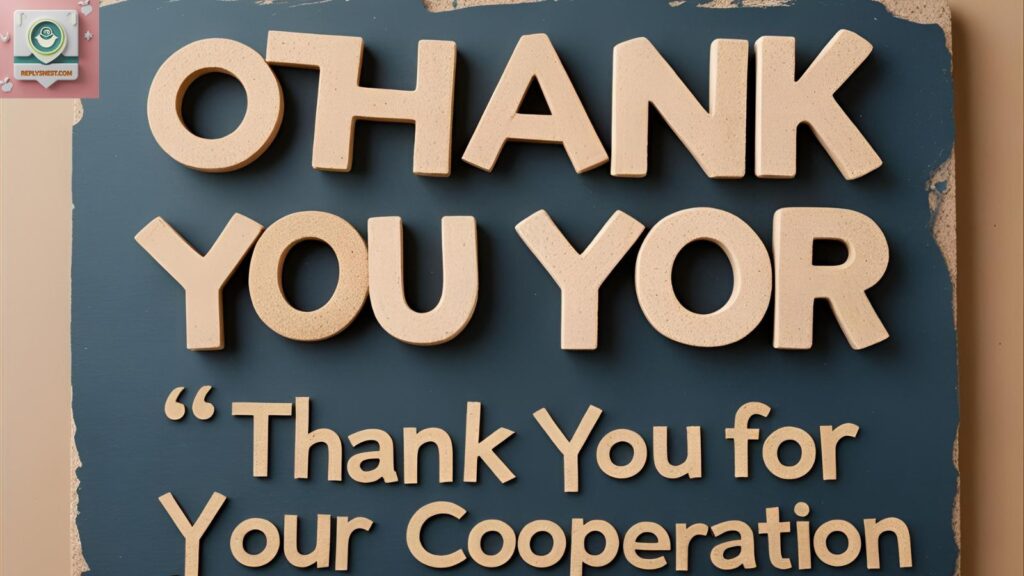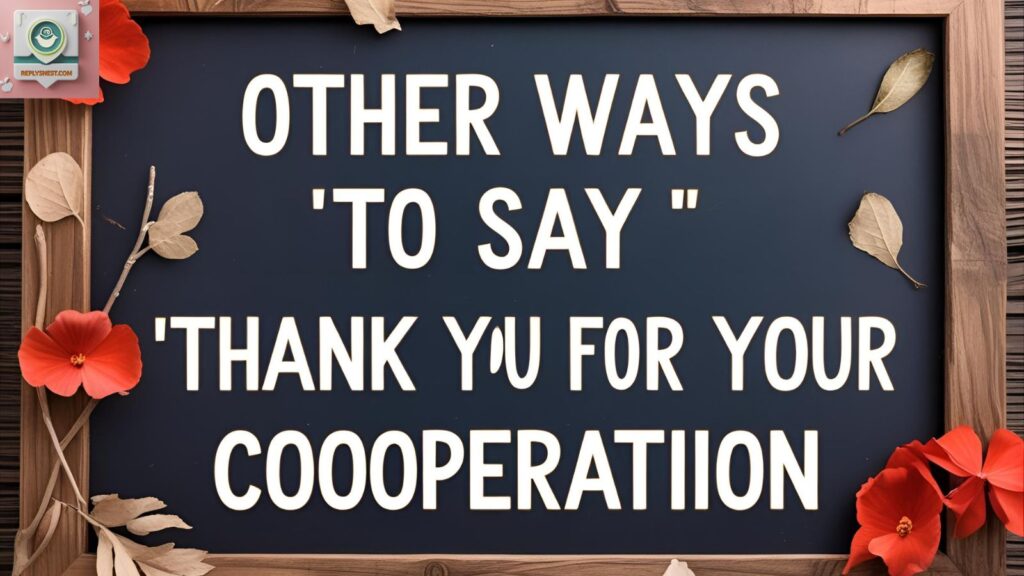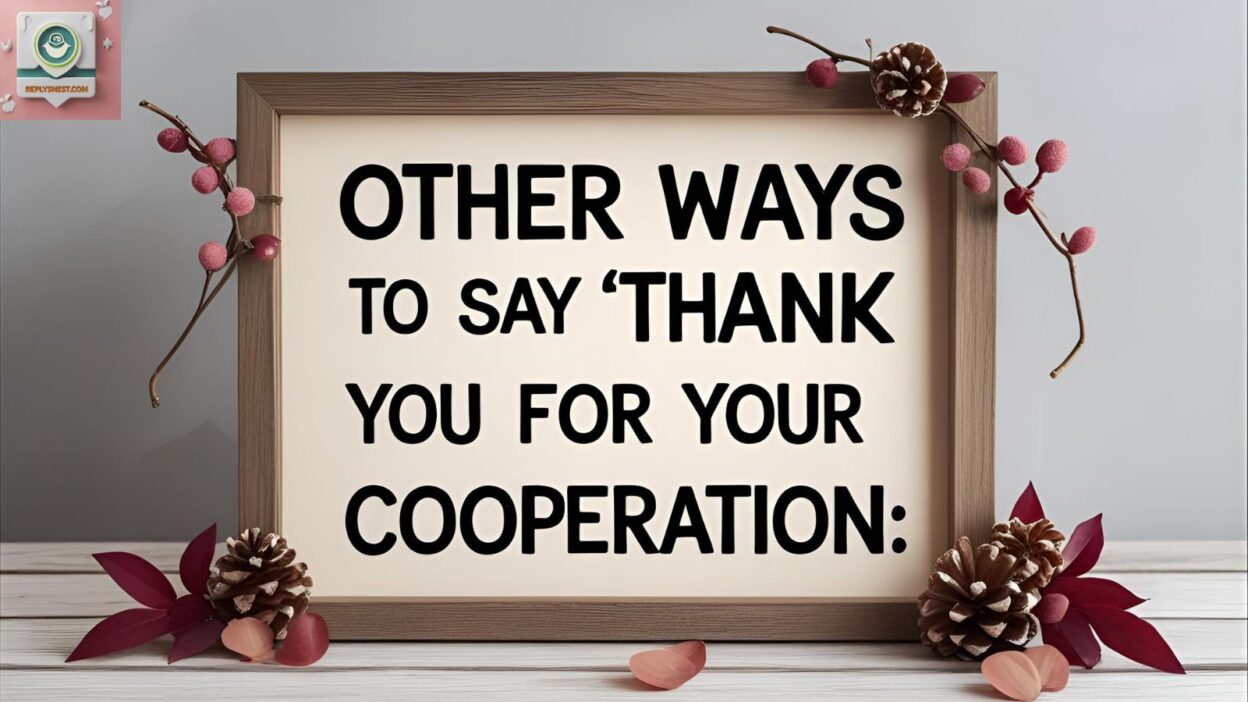When someone says “Thank you for your cooperation,” they’re appreciating your help or patience. How you reply matters it reflects your tone, professionalism, and openness. Other Ways to Say ‘Thank You For Your Cooperation’ gives you 30 meaningful, friendly, and respectful responses to keep communication clear and kind.
1. “You’re welcome. Happy to help!”
This reply is polite, warm, and professional. It acknowledges their thanks and shows you’re approachable. Great for work emails, meetings, or casual chats.
Best Use: Work or team settings.
Not Use: Legal or ultra-formal replies.
Other Ways to Say It: “My pleasure.” / “Glad I could help.”
Example:
Them: “Thank you for your cooperation.”
You: “You’re welcome. Happy to help!”
Read More: Funny Responses to “No Pressure”
2. “Anytime!”

Friendly and easy-going, this reply suggests you’re open to helping again. It’s short, casual, and ideal for everyday conversations.
Best Use: Friendly or recurring work interactions.
Not Use: High-level corporate communication.
Other Ways to Say It: “No problem.” / “Always here to help.”
Example:
Them: “Thanks again.”
You: “Anytime!”
3. “No worries at all.”

This relaxed and friendly response reassures the other person that helping out wasn’t a burden. It adds a touch of humility and approachability.
Best Use: Casual or internal team conversations.
Not Use: Legal or policy-heavy emails.
Other Ways to Say It: “No problem.” / “It was nothing.”
Example:
Them: “Thank you for your cooperation.”
You: “No worries at all.”
4. “It was my pleasure.”

This is polished, sincere, and works great in formal or customer-facing situations. It suggests you were genuinely happy to assist.
Best Use: Customer service or client communications.
Not Use: Super casual chats.
Other Ways to Say It: “I was glad to help.” / “I enjoyed assisting.”
Example:
Client: “Thanks for your cooperation.”
You: “It was my pleasure.”
5. “Of course!”
This quick reply is confident and reassuring. It works well when cooperation is expected or part of your role, without sounding robotic.
Best Use: Informal work chats or peer communication.
Not Use: Formal or scripted responses.
Other Ways to Say It: “Definitely.” / “Naturally.”
Example:
Coworker: “Thanks for stepping in.”
You: “Of course!”
6. “Glad I could help.”
Simple, kind, and to the point — this response shows you were happy to support and appreciated being part of the effort.
Best Use: Team settings, collaborations, and customer service.
Not Use: Legal correspondence.
Other Ways to Say It: “Happy to assist.” / “Always here to help.”
Example:
Them: “Thank you for your cooperation.”
You: “Glad I could help.”
7. “Not a problem.”
This reply is easygoing and puts the other person at ease. It shows you don’t view their request as a hassle.
Best Use: Casual workplace or friendly chats.
Not Use: High-stakes or sensitive issues.
Other Ways to Say It: “Don’t mention it.” / “No issue at all.”
Example:
Team Lead: “Thanks for the quick fix.”
You: “Not a problem.”
8. “Always happy to help.”
This reply communicates enthusiasm and reliability. It’s especially effective in customer interactions or service roles.
Best Use: Customer service, ongoing work relationships.
Not Use: One-time interactions.
Other Ways to Say It: “Glad to support.” / “Let me know if you need anything else.”
Example:
Client: “Thanks again!”
You: “Always happy to help.”
9. “You got it.”
This is upbeat and friendly, ideal for laid-back conversations. It signals your support with a casual, confident tone.
Best Use: Peer-to-peer, internal team chats.
Not Use: Professional emails or reports.
Other Ways to Say It: “Absolutely.” / “Right away.”
Example:
Coworker: “Thanks for covering me.”
You: “You got it.”
10. “No trouble at all.”
This reply is calm and kind. It assures the person that their request didn’t cause any difficulty or inconvenience.
Best Use: Everyday interactions and customer replies.
Not Use: When a more enthusiastic tone is needed.
Other Ways to Say It: “It was easy.” / “Didn’t mind at all.”
Example:
Them: “Thank you for your cooperation.”
You: “No trouble at all.”
11. “Don’t mention it.”
A humble way to say the help you gave was no big deal. This phrase plays down your effort while still showing politeness.
Best Use: Informal chats or peer discussions.
Not Use: Formal or official replies.
Other Ways to Say It: “No need to thank me.” / “It was nothing.”
Example:
Coworker: “Thanks again.”
You: “Don’t mention it.”
12. “It’s what I’m here for.”
This reply is great when you’re in a role where helping is expected. It feels supportive and confident, without sounding boastful.
Best Use: Customer service or team roles.
Not Use: Casual conversations outside of work.
Other Ways to Say It: “That’s my job.” / “Anytime you need.”
Example:
Client: “Thanks for your help.”
You: “It’s what I’m here for.”
13. “I’m glad we could work together.”
This is perfect when the cooperation was mutual. It emphasizes collaboration and shared success, not just your individual effort.
Best Use: Projects, partnerships, or team tasks.
Not Use: One-sided help or quick tasks.
Other Ways to Say It: “Great teamwork.” / “Happy we collaborated.”
Example:
Teammate: “Thanks for your cooperation.”
You: “I’m glad we could work together.”
14. “It was nothing, really.”
A modest and humble way to respond. It works best when you want to brush off praise without sounding cold.
Best Use: Friendly or lighthearted conversations.
Not Use: In professional or formal emails.
Other Ways to Say It: “No big deal.” / “Just happy to help.”
Example:
Friend: “Thank you for your cooperation.”
You: “It was nothing, really.”
15. “We’re in this together.”
This reply reflects solidarity and support. It’s perfect for situations involving shared effort or mutual challenges.
Best Use: Team or community efforts.
Not Use: Solo tasks or when speaking formally.
Other Ways to Say It: “We’re a team.” / “Together we got it done.”
Example:
Colleague: “Thanks for your cooperation.”
You: “We’re in this together.”
16. “Just doing my part.”
This keeps things humble and team-oriented. It acknowledges the thanks while highlighting a shared responsibility.
Best Use: Group projects or task-sharing settings.
Not Use: Customer service or formal writing.
Other Ways to Say It: “Pitching in.” / “Helping where I can.”
Example:
Teammate: “Thanks for your cooperation.”
You: “Just doing my part.”
17. “I’m here if you need anything else.”
A helpful, proactive phrase that offers continued support. It’s ideal after finishing a task or helping resolve an issue.
Best Use: Customer support or service roles.
Not Use: Casual peer chats.
Other Ways to Say It: “Let me know if you need more.” / “I’m around if needed.”
Example:
Client: “Thanks again!”
You: “I’m here if you need anything else.”
18. “It’s always a pleasure.”
This reply is both gracious and professional. It works well with clients, colleagues, and even formal business relationships.
Best Use: Email sign-offs, client or supervisor communication.
Not Use: Highly informal settings.
Other Ways to Say It: “A pleasure working with you.” / “Always glad to help.”
Example:
Supervisor: “Thanks for your cooperation.”
You: “It’s always a pleasure.”
19. “Let me know if there’s anything else.”
This shows initiative and openness to continue helping. It’s polite and makes the other person feel supported.
Best Use: After completing a task or giving assistance.
Not Use: When the conversation is already concluded.
Other Ways to Say It: “Here if you need me.” / “Happy to continue helping.”
Example:
Them: “Thanks for your help.”
You: “Let me know if there’s anything else.”
20. “We make a great team.”
This is cheerful and collaborative, perfect for moments of successful teamwork or joint effort.
Best Use: Team settings, coworkers, or successful project outcomes.
Not Use: Solo contributions or formal responses.
Other Ways to Say It: “Teamwork makes the dream work.” / “Proud of what we did together.”
Example:
Colleague: “Thanks again!”
You: “We make a great team.”
21. “I appreciate the opportunity.”
This reply shows gratitude in return, making it perfect for professional environments. It says you value the experience just as much as they value your cooperation.
Best Use: Projects, interviews, client meetings.
Not Use: Informal chats.
Other Ways to Say It: “Thanks for involving me.” / “Grateful to be part of it.”
Example:
Them: “Thank you for your cooperation.”
You: “I appreciate the opportunity.”
22. “That’s what teamwork is all about.”
This emphasizes collaboration and mutual support. It’s a great phrase to build morale and a sense of unity.
Best Use: Team efforts and project debriefs.
Not Use: Solo contributions or formal replies.
Other Ways to Say It: “We got it done together.” / “Good teamwork!”
Example:
Coworker: “Thanks for your cooperation.”
You: “That’s what teamwork is all about.”
23. “Happy to be part of it.”
This reply is inclusive and uplifting. It works well when you want to highlight your involvement in a positive way.
Best Use: Group tasks, creative work, or collaborations.
Not Use: Ultra-professional or formal communication.
Other Ways to Say It: “Glad to join in.” / “It felt good to help.”
Example:
Teammate: “Thanks for being involved.”
You: “Happy to be part of it.”
24. “Thanks for trusting me.”
This is a gracious way to acknowledge their appreciation while recognizing the trust they placed in you to get the job done.
Best Use: Leadership roles, delegated work, or high-responsibility tasks.
Not Use: Basic or casual cooperation.
Other Ways to Say It: “I’m honored you relied on me.” / “Thanks for the confidence.”
Example:
Manager: “Thank you for your cooperation.”
You: “Thanks for trusting me.”
25. “We got through it together.”
A heartfelt and unifying response, especially after a difficult task or intense collaboration. It adds emotion and reinforces connection.
Best Use: After challenges, deadlines, or crises.
Not Use: Light or routine cooperation.
Other Ways to Say It: “We pulled through.” / “We made it work.”
Example:
Teammate: “Thanks for your support.”
You: “We got through it together.”
Conclusion: Responding with Empathy Makes a Difference
Responding to “Thank you for your cooperation” may seem small, but the right words can build stronger relationships, boost morale, and reflect emotional intelligence. Whether you’re replying to a boss, colleague, client, or friend, these 25 thoughtful responses help you communicate with care, professionalism, and warmth. In my own work across customer support, team projects, and leadership roles, I’ve seen how a kind reply even just a few words can leave a lasting impression.



